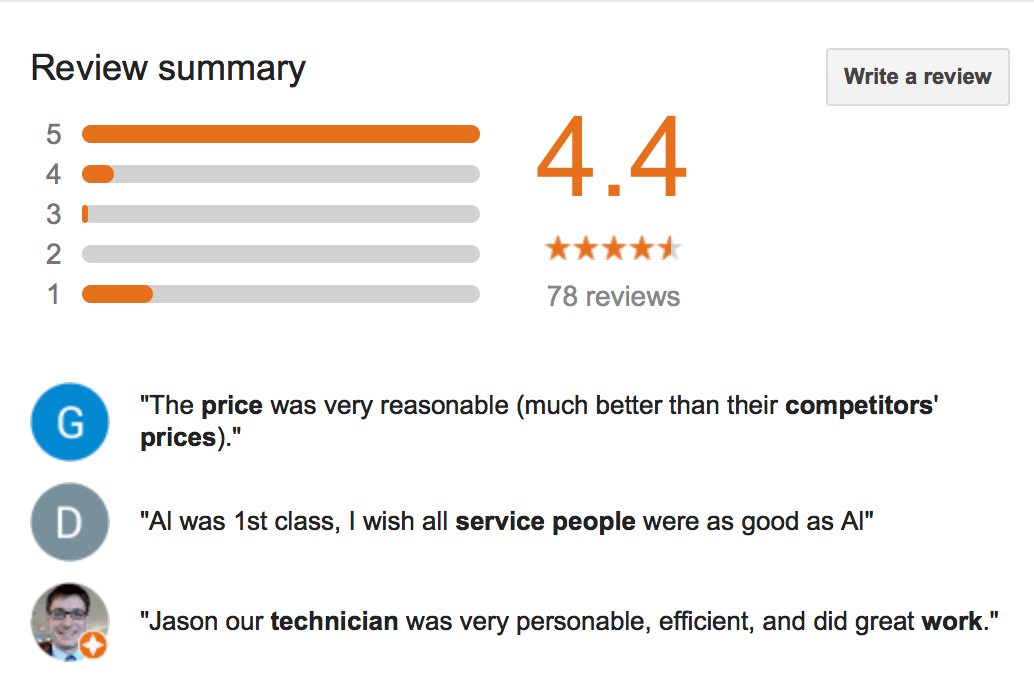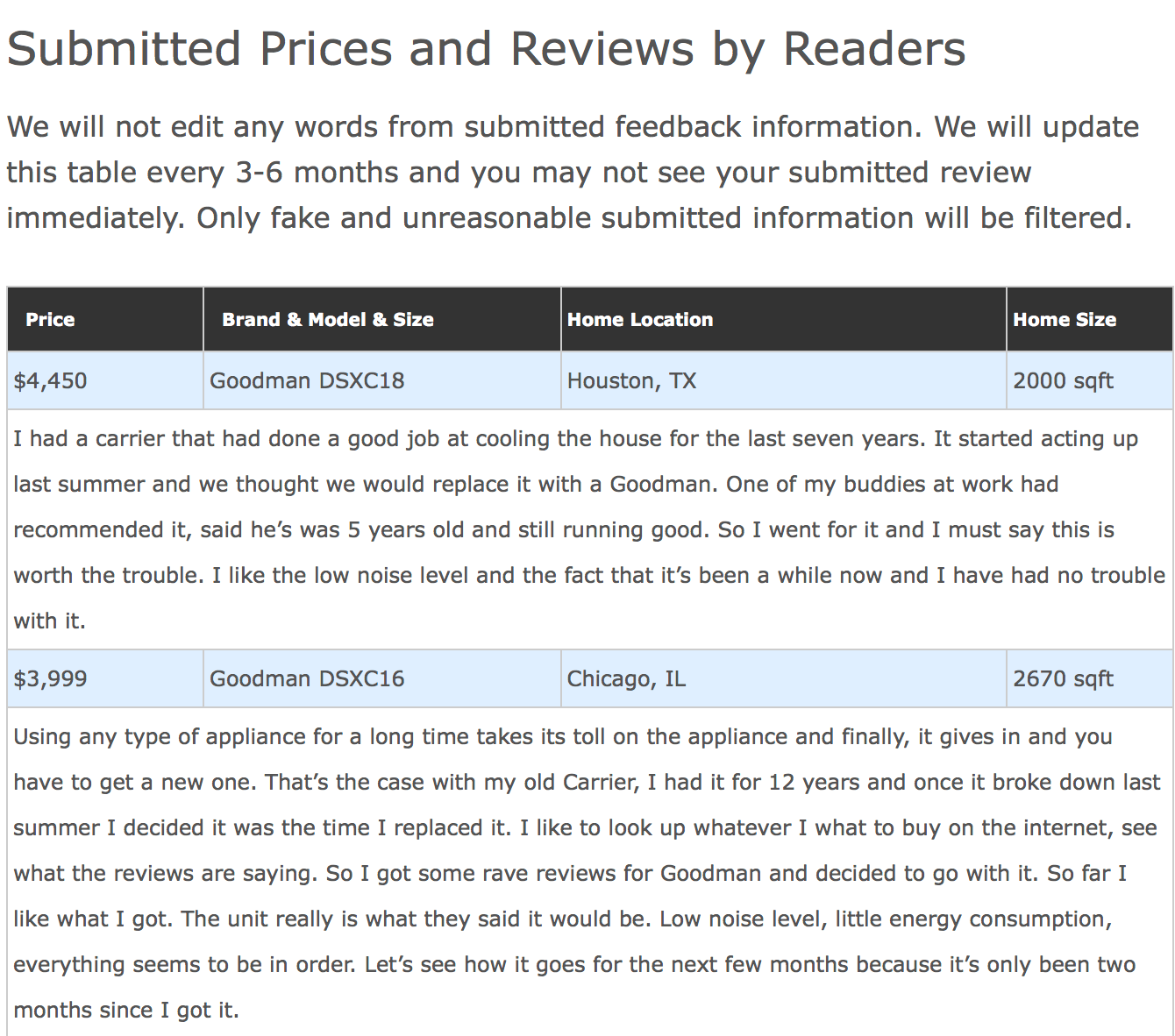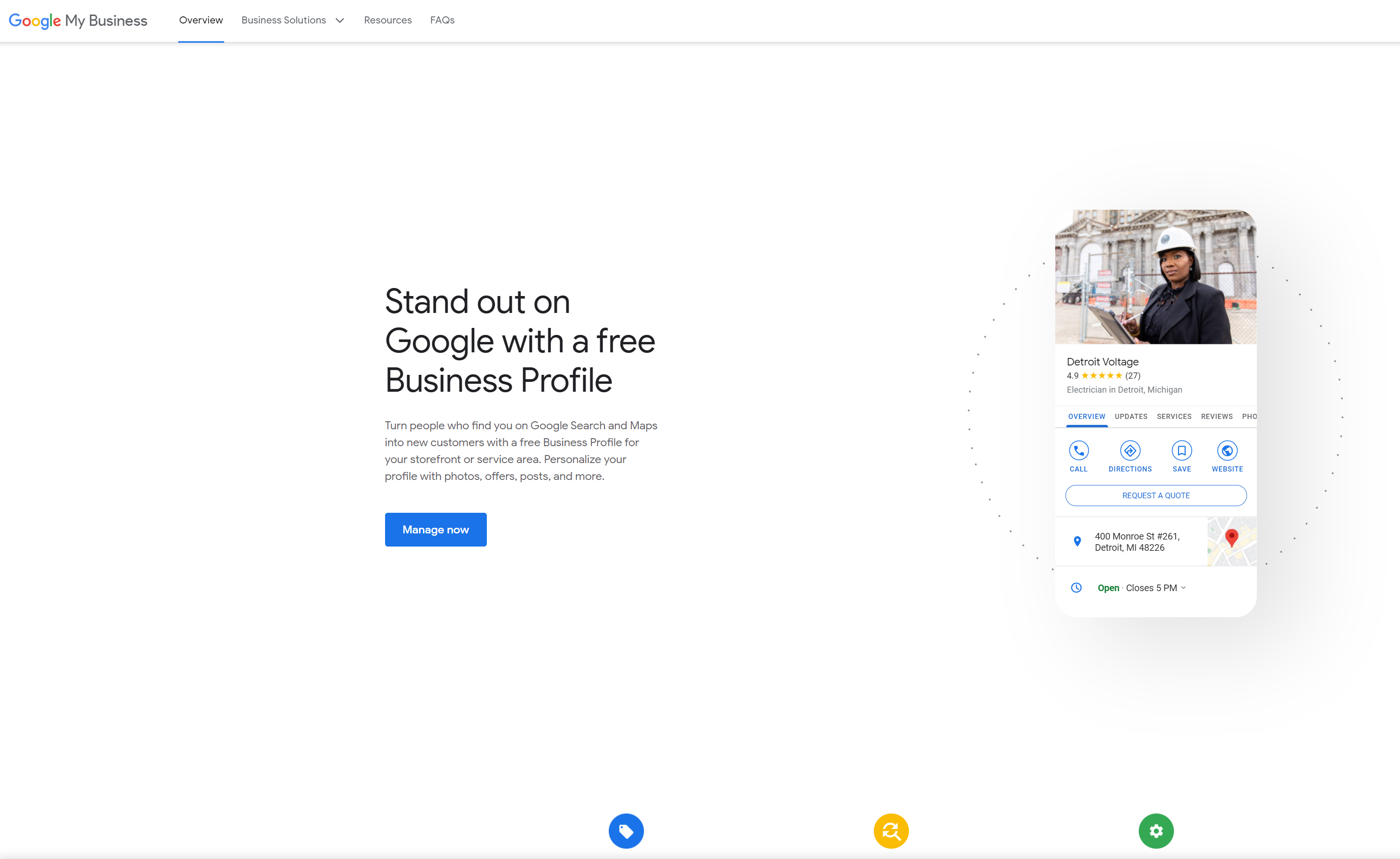- Home
- Digital Marketing
- Learn
- 7 Ways to Get More Reviews for Your Business
7 Ways to Get More Reviews for Your Business (And How to Manage Reviews Like a Pro)
They say they love you, but then they don’t tell anyone. So how can you be confident that when someone looks for opinions about you online, they’ll find glowing reviews?
The problem is likely related to the fact that you aren’t actively encouraging your customers to write reviews. And since you probably already know that incentivizing is a bad idea, you may be afraid to. So, how can you get more reviews for your business without violating the rules of review sites? Keep reading. Or, if you’d rather speak with a specialist, you can reach us at 888-601-5359.
WebFX is a Partner in Driving Results
Hear from HydroWorx, who saw a 131% increase in organic forms by partnering with WebFX
Where do I get online reviews?
When you’re looking to earn reviews for your business, it’s important to know where you can earn them. Here are three places you can earn reviews:
1. Google Business Profile
This is one of the most common places people will see reviews for your business. If they conduct a search on Google looking for a business near them, they will see the business listing and the star review.
Google Business Profile is a great place to earn reviews. Whether users Google your business directly or look for businesses like yours, your listing will pop up with reviews. You will see the star rating and quotes from three reviews.
The reviews on your Google Business Profile listing affect your ranking too. If you want your listing to appear in front of more relevant leads, you must earn many positive reviews for your business.
If you haven’t claimed your Google Business Profile listing, you can visit their website to claim your business. Once you claim your business listing, fill out your entire profile. Add photos, contact information, business information, and verify your address is correct.
A complete profile will help drive more people to your page. They will find all the information they need and be more likely to choose your business because they feel informed.
Claiming your Google Business Profile listing will help you drive more leads to your business, which helps you earn more reviews. You can see some testimonial examples from Google Business Profile below:

2. Third-party sites
Third-party sites are a great way for you to earn online reviews. There are two options for third-party sites.
Industry-specific review sites
Industry-specific review sites help people find reviews on you and your competitors. These industry review sites impact your ranking in the search results. If you want to maintain a good ranking, you must track your reviews on these sites.
If you’ve ever shopped around for a car, you may have used sites like Cars.com or CarGurus.com to look for the right car. These are industry-specific review sites that help you find the right car.
Let’s say that you own an HVAC company. If someone is researching different HVAC companies, they may check out an HVAC review website to compare HVAC companies near them to see which one has the best ratings.
This creates a convenient way for people to look at all related businesses in one area. They can comparison shop and see which ones offer the best services with the best reviews.
If you want to stand out from your competitors, monitor the reviews on these sites. Respond to the reviews and engage with your audience. You’ll earn more new leads in the long run by interacting with reviews on these sites.
Product review sites
Product review sites are third-party sites specifically designed to help companies earn reviews while vetting them. When people research about different products, they turn to these sites to get unbiased reviews.
The biggest concern when looking at reviews is vetting them for accuracy. Many people leave false reviews, whether positive or negative, that can skew the actual reviews. This makes it challenging for people to know if a product is good.
With third-party sites, a third-party company vets the reviews. This means that visitors are more likely to leave reviews on these sites because they know the false reviews will be vetted, and their review will more accurately measure your product’s quality.
This also means that people are more likely to trust the reviews on these sites. Since false reviews are removed and the company with the product can’t manipulate the reviews, people find them to be an accurate representation.
If you have positive reviews on these sites, you’ll want to integrate these reviews on to your own page. Many third-party sites will enable you to add their reviews to your page.

3. Social media
Driving social media reviews is essential for your business, as many people will leave feedback on your social media pages. Platforms like Facebook allow users to share their experience after visiting your business. They can let other people, who find your business through Facebook, to review their experience.
Social media reviews provide your audience with the opportunity to review their experience with your business. They can easily look up your business through social media platforms and write reviews. On other platforms, they can tag your business and write their opinion.
It’s an easy way to drive social media reviews for your business because people are already engaged on these sites. They only have to put in a little effort to find your business and write the review.
How to get more reviews with these 7 strategies
It’s important to have as many reviews as possible to increase your company’s credibility. Here are our 7 favorite ways to get more reviews for your business.
#1: Encourage reviews in person
This seems so logical, yet many businesses don’t do it. If someone thanks you for your amazing customer service or remarks on the quality of your products, tell them you’d appreciate it if they shared that sentiment on Yelp or another review site. You shouldn’t do this with every customer, but if someone seems particularly impressed, there’s a chance they’ll do it.
#2: Prominently display your “People Love Us on Yelp” sticker
If your business is fortunate enough to receive a sticker directly from Yelp, be sure to display it prominently in a store window. Not only will this show passersby that your business is well-liked, but it will also remind those who make a purchase to go to the site and leave a review.

#3: Put links on your website
Is there a link on your website that sends people right to your preferred review site? If not, consider adding one. Without a link that tells customers exactly where to go, it can be difficult for them to find the review page, or they may never think to review your site.
When you add a link, it gives customers an opportunity to go directly to where they can review your business, and increase the amount of reviews you receive.
#4: Claim your business
Be sure to claim your business on review sites like Google and Yelp so that you can update your profile and monitor reviews. If you don’t claim your listing, it’s basically wasted real estate! When you claim your business, you’ll be able to craft your profile to include important details about your business, monitor reviews, and even provide a level of customer service to site visitors.
Also, check the review sites where you already have profiles listed. Has anything changed? Do you need to update the profiles or modify them in any way to bring them up to date? For the best reviews (and overall presence), your profiles should always be up-to-date!

#5: Consistently thank customers for their reviews.
Once you’ve claimed your business, be sure to respond to reviews. Even if a review isn’t as positive as you would like, thank the reviewer for the time, and if they made a complaint, address it. By acknowledging both compliments and complaints, you can get more customer reviews by showing both current and potential customers that you care about making them happy.
#6: Send out emails to customers after they make a purchase
Chances are good that you’ve received emails like this. You make a purchase online, and a day or so after it arrives at your doorstep, you get an email asking you to write a review. Even if 90% of these emails are ignored, you’ll still get more reviews than you would have otherwise. And if you automate the emails, you won’t be spending any time to solicit them.

#7: Add calls to action to your emails
If you have an email newsletter (and you should!), consider adding a link to your review profiles at the bottom of your template. By including a call to action in emails that are sent to customers who specifically signed up for your marketing messages, you know that you are reaching an audience that is already familiar with your business.
3 tips for managing online reviews in 2025
As online and social media reviews start flooding in, it’s crucial that you keep track of them. Whether they are positive or negative reviews, you always want to keep an eye on what people are saying about your business so you can respond effectively.
1. Respond to reviews
Driving social media and online reviews are important, but responding to reviews is equally a crucial part of building up your business. When people leave reviews, there is an expectation that you will respond and engage with those reviews, whether positive or negative. If you want your reviews to drive success for your business, you must respond to reviews.
You can thank people for their positive reviews and address issues with negative reviews. The important part is that you interact with reviews and show initiative to solve problems.

2. Stay professional
The last thing you want to do is argue with people and give them attitude. You may get reviews that are harsh and aggressive, but you don’t want to mirror that behavior in your response. Always remain professional when responding to reviews.
If you come off as aggressive or inappropriate, it will make your business look bad, and people won’t want to purchase from you. It’s best to keep it civil and try to solve people’s problems.
Don’t just offer an explanation. You need to show your audience that you’re willing to take action to rectify issues. Offer solutions and try to make the situation better for your audience.
3. Track your reviews
To keep on top of new online or social media reviews, you must track them. You can set daily reminders to check for new reviews on platforms like Yelp, Glassdoor, Facebook, and more.
Dedicate time to tracking and managing reviews. You can even use a review management software to consolidate reviews across different platforms and keep track of them. It’s a valuable way to get more reviews online because you can actively respond and interact with your audience.
If you want help managing your reviews, working with the top reputation management companies can help you control your brand perception online.
Are you ready to benefit from having tons of reviews about your business online?
If so, it’s time to start being proactive. These 7 strategies should help you get started, but if you’d like some additional help, feel free to contact us! Our dedicated team of Internet marketing professionals is more than happy to help you manage all aspects of your online presence.
Table of Contents
- Where do I get online reviews?
- How to get more reviews with these 7 strategies
- #1: Encourage reviews in person
- #2: Prominently display your “People Love Us on Yelp” sticker
- #3: Put links on your website
- #4: Claim your business
- #5: Consistently thank customers for their reviews.
- #6: Send out emails to customers after they make a purchase
- #7: Add calls to action to your emails
- 3 tips for managing online reviews in 2025
- Are you ready to benefit from having tons of reviews about your business online?
Related Resources
- 6 Tips for Creating a Professional and Memorable B2B Logo Design
- 7 CTV Trends to Watch in 2025
- 7 Digital Marketing Strategies for Franchises
- 7 Tips for Repairing Your Company’s Online Reputation
- 7+ Digital Marketing Solutions for Growing Your Business
- 8 Emarketing Strategies to Invigorate Online Presence
- 8 Expert Digital Marketing Optimization Tips to Follow
- 8 Fresh Marketing Ideas for Small Businesses
- 8 WordPress CRM Plugins to Manage Your Customers Better
- Case Study: Indie Label Monstercat and Their Innovative Marketing Tactics
Marketing Tips for Niche Industries
- 7 Optometrist Marketing Strategies to Attract Patients
- 7 Optometrist Marketing Strategies to Attract Patients
- 7 Reasons Why You Need Ecommerce for Industrial Products
- 7 Reasons Why You Need Ecommerce for Industrial Products
- 7 Ways to Market Your Brewery Online
- 7+ Construction Industry Trends to Watch for in 2025
- 70+ Retail Statistics Marketers Should Know in 2025
- 8 Finance Industry Trends to Know and Follow in 2025
- 8 Health Insurance Marketing Ideas to Drive Up Your Revenue
- 8 Tech Industry Trends to Watch out for in 2025
Additional Reading
- 5 Successful Ways to Recruit Employees with Internet Marketing
- 5 Tips for How to Market to Millennials Online
- 5 Ways to Increase Online Response Rates
- 5 Ways to Stretch Your Marketing Budget Online
- 6 Main Objectives of Internet Marketing
- 6 Reasons to Use Wistia to Host Your Videos
- 7 Advantages of Using Video in Your Marketing Plan
- 7 Branding App Tips to Help You Drive Results
- 7 Customer Acquisition Strategies for Earning Clients
- 7 Highly Successful Ways to Get Traffic to a New Website
- 7 Reasons Content is Essential to Digital Marketing
- 7 Strategies to Increase Online Consumer Engagement
- 8 Considerations when You Hire an Online Marketing Specialist
- 8 Emarketing Strategies to Invigorate Online Presence
- 8 Ways to Assess Inbound Marketing

